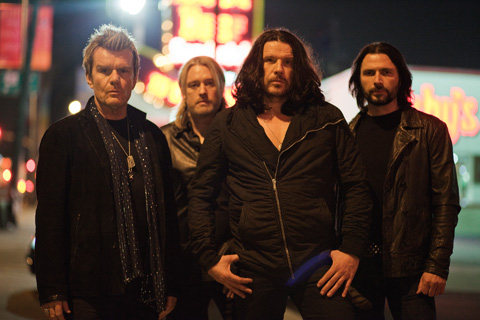
SHE WRITES SANCTUARY The Cult, still going strong, mixed American hard rock with British new
wave, merging underground artiness with a hard-pop whump. |
There is a difference between an unknown musical artist and a superstar, and that difference isn't necessarily musical — it's mythological. Our modern world may have slain God and transformed the sacred into the banal, but we who worship at the altar of rock still look to our deities for ideal forms and majestic works. We expect the unreal, the impossible; we want those who have been to the top of the mountain to tell us what it was like. In rock's 60-year lifecycle from fetus to assisted-living home resident, few bands have navigated the highs and lows of the form's mythology better than the Cult — and to hear singer Ian Astbury and guitarist Billy Duffy tell it, it's a gift to have lived to sing their song in this twilight time.
>> Q&A: Expanded conversations with the Cult: Billy Duffy and Ian Astbury <<
Astbury dropped out for a few years in the '90s to climb mountains in Tibet, but only after a decade and a half of climbing the figurative mountain of rock success, taking his strange early-'80s post-punk project Southern Death Cult and morphing it into the eventually platinum, major-label stadium-rocking Cult beloved by late-'80s/early-'90s rock fans. Like the Colossus of Rhodes, the Cult had feet on multiple shores, mixing American hard rock with British new wave, merging underground artiness with a hard-pop whump. With the one-two-three progression of 1985's Love, '87's Electric, and '89's Sonic Temple, the band formed a fanbase that mixed metalheads, punks, Smiths/Cure Anglo-mopes, classic-rock fans, and hard rockheads. "The mountain was there to be climbed," Astbury intones, describing the band's ascent. "And you get to the top and see everything, all there for the offering. And believe me, I was offered it all."
But success was just part of the trip, as the Cult's hybridized approach stripped down to its sonic essentials, laying bare the mythos behind the nonsense. "We wanted to know what it would sound like if the Stooges played a Hendrix song, or the Pistols did a tune by Free," explains Duffy. It might sound like "She Sells Sanctuary," or "Fire Woman," or any of the Cult's hip-shaking, fist-pumping classics, paeans to revelries both ancient and primal.